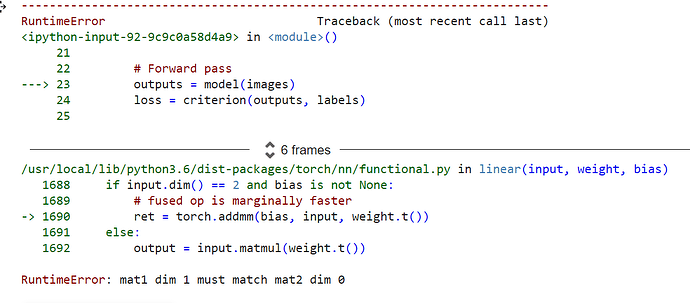I got this error when i run my code "RuntimeError: mat1 dim 1 must match mat2 dim 0 ". Can anyone help to solve this problem ?
The model is :
class Flatten(nn.Module):
def forward(self, input):
return input.view(input.size(0), -1)
class Unflatten(nn.Module):
def __init__(self, channel, height, width):
super(Unflatten, self).__init__()
self.channel = channel
self.height = height
self.width = width
def forward(self, input):
return input.view(input.size(0), self.channel, self.height, self.width)
class ConvVAE(nn.Module):
def __init__(self, latent_size):
super(ConvVAE, self).__init__()
self.latent_size = latent_size
self.encoder = nn.Sequential(
nn.Conv2d(19, 64, kernel_size=3, stride=2, padding=1),
nn.ReLU(),
nn.Conv2d(64, 128, kernel_size=3, stride=2, padding=1),
nn.ReLU(),
Flatten(),
nn.Linear(80000, 1024),
nn.ReLU()
)
# hidden => mu
self.fc1 = nn.Linear(1024, self.latent_size)
# hidden => logvar
self.fc2 = nn.Linear(1024, self.latent_size)
self.decoder = nn.Sequential(
nn.Linear(self.latent_size, 1024),
nn.ReLU(),
nn.Linear(1024,80000),
nn.ReLU(),
Unflatten(128, 25, 25),
nn.ReLU(),
nn.ConvTranspose2d(128, 64, kernel_size=3, stride=2, padding=1),
nn.ReLU(),
nn.ConvTranspose2d(64, 19, kernel_size=3, stride=2, padding=1),
nn.Sigmoid()
)
def encode(self, x):
h = self.encoder(x)
mu, logvar = self.fc1(h), self.fc2(h)
return mu, logvar
def decode(self, z):
z = self.decoder(z)
return z
def reparameterize(self, mu, logvar):
if self.training:
std = torch.exp(0.5 * logvar)
eps = torch.randn_like(std)
return eps.mul(std).add_(mu)
else:
return mu
def forward(self, x):
mu, logvar = self.encode(x)
z = self.reparameterize(mu, logvar)
return self.decode(z), mu, logvar
The main code is :
def main():
parser = argparse.ArgumentParser(description='Convolutional VAE MNIST Example')
parser.add_argument('--result_dir', type=str, default='results', metavar='DIR',
help='output directory')
parser.add_argument('--batch_size', type=int, default=100, metavar='N',
help='input batch size for training (default: 128)')
parser.add_argument('--epochs', type=int, default=10, metavar='N',
help='number of epochs to train (default: 10)')
parser.add_argument('--seed', type=int, default=1, metavar='S',
help='random seed (default: 1)')
parser.add_argument('--resume', default='', type=str, metavar='PATH',
help='path to latest checkpoint (default: None')
# model options
parser.add_argument('--latent_size', type=int, default=32, metavar='N',
help='latent vector size of encoder')
parser.add_argument("-f", "--fff", help="a dummy argument to fool ipython", default="1")
args = parser.parse_args()
torch.manual_seed(args.seed)
kwargs = {'num_workers': 1, 'pin_memory': True} if cuda else {}
train_dataset = CustomDataset(train_image_paths, train_mask_paths, transform=transform, train=True)
train_loader = torch.utils.data.DataLoader(train_dataset, batch_size=1, shuffle=True, num_workers=0)
test_dataset = CustomDataset(test_image_paths, test_mask_paths, transform=transform, train=False)
test_loader = torch.utils.data.DataLoader(test_dataset, batch_size=1, shuffle=False, num_workers=0)
model = ConvVAE(args.latent_size).to(device)
optimizer = optim.Adam(model.parameters(), lr=1e-3)
start_epoch = 0
best_test_loss = np.finfo('f').max
# optionally resume from a checkpoint
if args.resume:
if os.path.isfile(args.resume):
print('=> loading checkpoint %s' % args.resume)
checkpoint = torch.load(args.resume)
start_epoch = checkpoint['epoch'] + 1
best_test_loss = checkpoint['best_test_loss']
model.load_state_dict(checkpoint['state_dict'])
optimizer.load_state_dict(checkpoint['optimizer'])
print('=> loaded checkpoint %s' % args.resume)
else:
print('=> no checkpoint found at %s' % args.resume)
writer = SummaryWriter()
for epoch in range(start_epoch, args.epochs):
train_loss = train(epoch, model, train_loader, optimizer, args)
test_loss = test(epoch, model, test_loader, writer, args)
# logging
writer.add_scalar('train/loss', train_loss, epoch)
writer.add_scalar('test/loss', test_loss, epoch)
print('Epoch [%d/%d] loss: %.3f val_loss: %.3f' % (epoch + 1, args.epochs, train_loss, test_loss))
is_best = test_loss < best_test_loss
best_test_loss = min(test_loss, best_test_loss)
save_checkpoint({
'epoch': epoch,
'best_test_loss': best_test_loss,
'state_dict': model.state_dict(),
'optimizer': optimizer.state_dict(),
}, is_best)
with torch.no_grad():
sample = torch.randn(64, 32).to(device)
sample = model.decode(sample).cpu()
img = make_grid(sample)
writer.add_image('sampling', img, epoch)
save_image(sample.view(64, 1, 28, 28), 'results/sample_' + str(epoch) + '.png')
if __name__ == '__main__':
main()
And the error code is :
train: 0%| | 0/7 [00:00<?, ?it/s]
---------------------------------------------------------------------------
RuntimeError Traceback (most recent call last)
<ipython-input-10-ea45d861fe2d> in <module>()
84
85 if __name__ == '__main__':
---> 86 main()
87
9 frames
/usr/local/lib/python3.6/dist-packages/torch/nn/functional.py in linear(input, weight, bias)
1688 if input.dim() == 2 and bias is not None:
1689 # fused op is marginally faster
-> 1690 ret = torch.addmm(bias, input, weight.t())
1691 else:
1692 output = input.matmul(weight.t())
RuntimeError: mat1 dim 1 must match mat2 dim 0
